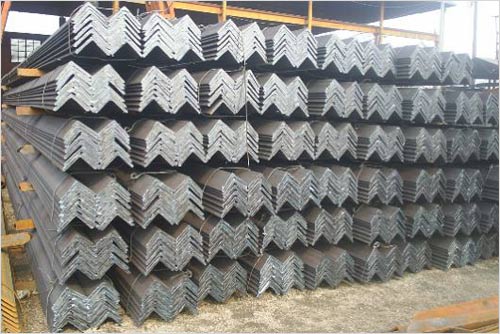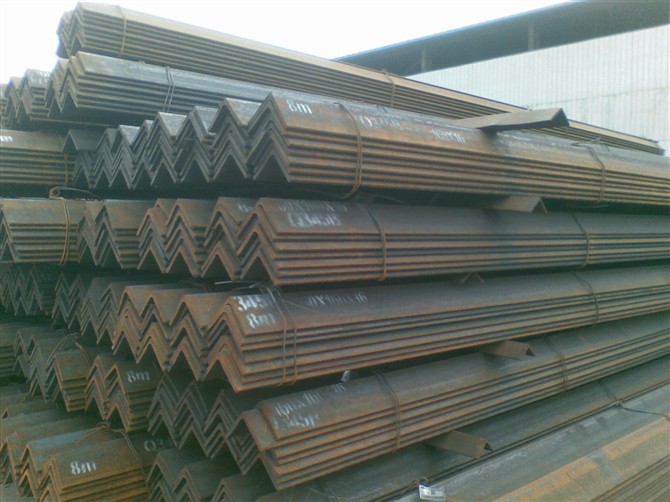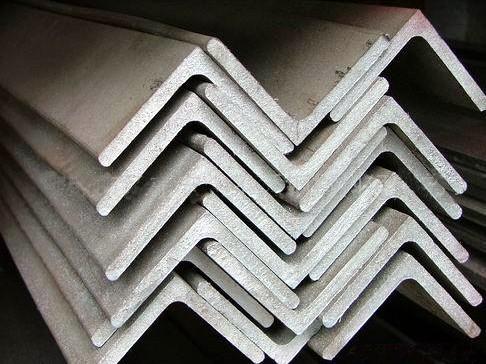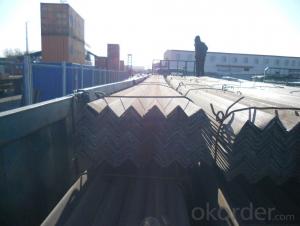Q345 Q235 equal angle steel bar AISI,ASTM,BS,GB,JIS
- Loading Port:
- Tianjin
- Payment Terms:
- TT OR LC
- Min Order Qty:
- 35 m.t.
- Supply Capability:
- 40000 m.t./month
OKorder Service Pledge
OKorder Financial Service
You Might Also Like
Specifications
1.angle steel
2.Dimensions: 20-250mm
3.Reasonable price
4.Honest attitude
5.Certificates:BUV,TUV
Company Information :
Our company is devoted to the construction of the stainless steel industry, We sincerely provide customers with quality services . Now, our products sell well in more than 20 countries and regions .
We believe that where there is a will there is a way,we assure you of a low price and the most satisfactory services.
Product Description :
Specifications
Mild angle steel
1.size: 2#--20#
2.material: Q235B,SS400,ST37-2,S235JR
3.length:6m--12m
4.Chinese standard
Specification
| Weight (kg/m) | Specification
| Weight |
25*25*3 | 1.124 | 90*90*8 | 10.946 |
25*25*4 | 1.459 | 90*90*10 | 13.476 |
30*30*3 | 1.373 | 100*100*6 | 9.366 |
30*30*4 | 1.786 | 100*100*7 | 10.83 |
40*40*3 | 1.852 | 100*100*8 | 12.276 |
40*40*4 | 2.422 | 100*100*10 | 15.12 |
40*40*5 | 2.976 | 100*100*12 | 17.898 |
45*45*3 | 2.088 | 110*110*7 | 11.928 |
45*45*4 | 2.736 | 110*110*8 | 13.532 |
45*45*5 | 3.369 | 110*110*10 | 16.69 |
50*50*3 | 2.332 | 110*110*12 | 19.782 |
50*50*4 | 3.059 | 125*125*8 | 15.504 |
50*50*5 | 3.77 | 125*125*10 | 19.133 |
50*50*6 | 4.465 | 125*125*12 | 22.696 |
63*63*5 | 4.822 | 125*125*14 | 26.193 |
63*63*6 | 5.721 | 140*140*10 | 21.488 |
63*63*8 | 7.469 | 140*140*12 | 25.522 |
70*70*5 | 5.397 | 140*140*14 | 29.49 |
70*70*6 | 6.406 | 160*160*10 | 24.729 |
70*70*7 | 7.398 | 160*160*12 | 29.391 |
70*70*8 | 8.373 | 160*160*14 | 33.987 |
75*75*5 | 5.818 | 160*160*16 | 38.518 |
75*75*6 | 6.905 | 180*180*12 | 33.159 |
75*75*7 | 7.976 | 180*180*14 | 38.383 |
75*75*8 | 9.030 | 180*180*16 | 43.542 |
75*75*10 | 11.089 | 180*180*18 | 48.634 |
80*80*6 | 7.376 | 200*200*14 | 42.894 |
80*80*7 | 8.525 | 200*200*16 | 48.68 |
80*80*8 | 9.658 | 200*200*18 | 54.401 |
80*80*10 | 11.874 | 200*200*20 | 60.056 |
90*90*6 | 8.35 | 200*200*24 | 71.168 |
90*90*7 | 9.656 |



- Q:How do steel angles resist corrosion?
- Steel angles resist corrosion through a process called passivation. Passivation is the formation of a protective layer on the surface of the steel that acts as a barrier against corrosive elements such as moisture, oxygen, and chemicals. Steel angles are typically made from stainless steel, which contains a minimum of 10.5% chromium. Chromium is a key element that enables the formation of a thin, invisible layer of chromium oxide on the surface of the steel. This oxide layer is highly stable and prevents further corrosion from occurring. The chromium oxide layer acts as a physical barrier, protecting the underlying steel from the corrosive effects of the environment. It is also self-healing, meaning that if the oxide layer is damaged or scratched, it will naturally reform and restore its protective properties. Additionally, stainless steel angles may contain other alloying elements such as nickel and molybdenum, which further enhance their corrosion resistance. These elements contribute to the formation of a more stable oxide layer and provide additional protection against localized corrosion, such as pitting and crevice corrosion. Furthermore, steel angles can be treated with various surface finishes or coatings to enhance their resistance to corrosion. These treatments can include processes like hot-dip galvanizing, electroplating, or applying organic coatings. These additional layers act as an extra barrier, preventing corrosive substances from reaching the steel surface. Overall, steel angles resist corrosion by forming a protective layer of chromium oxide on their surface, which acts as a barrier against corrosive elements. The inclusion of other alloying elements and the application of surface treatments further enhance their ability to withstand corrosion in various environments.
- Q:What are the different methods of connecting steel angles to other structural elements?
- There are several methods of connecting steel angles to other structural elements, depending on the specific application and load requirements. One common method is through welding. Welding involves melting and fusing the steel angle to the other structural element using intense heat. This creates a strong and durable connection that can withstand high loads. Welding is often used when the connection needs to be permanent and when the load requirements are significant. Another method is through bolting. Bolting involves using bolts and nuts to secure the steel angle to the other structural element. This method allows for easy disassembly and reassembly if needed, making it more flexible than welding. Bolting is often used when the connection needs to be adjustable or when the load requirements are relatively lower. Riveting is another method that can be used to connect steel angles to other structural elements. Riveting involves joining the steel angle and the other element by inserting a metal pin, called a rivet, through aligned holes and then deforming the end of the rivet to secure it in place. This method creates a strong and reliable connection, but it may be more time-consuming and labor-intensive compared to welding or bolting. Additionally, adhesive bonding can also be used to connect steel angles to other structural elements. This method involves using specialized adhesives that can bond the surfaces of the steel angle and the other element together. Adhesive bonding can provide a strong and uniform connection, and it is often used when aesthetics are important or when joining dissimilar materials. In summary, the different methods of connecting steel angles to other structural elements include welding, bolting, riveting, and adhesive bonding. The choice of method depends on factors such as the load requirements, desired flexibility, ease of assembly and disassembly, and the specific application.
- Q:Can steel angles be used as framing members for suspended ceilings?
- Yes, steel angles can be used as framing members for suspended ceilings. They provide structural support and stability to hold the ceiling tiles or panels in place.
- Q:How do steel angles perform under cyclic or alternating loading conditions?
- Steel angles perform well under cyclic or alternating loading conditions due to their structural properties. Steel is known for its high strength and durability, which allows angles to withstand repeated loading without significant deformation or failure. Under cyclic loading, the steel angles exhibit a phenomenon called fatigue. Fatigue occurs when a material is subjected to repeated stress cycles, leading to cumulative damage and potential failure over time. However, steel has a high fatigue strength compared to other materials, making it highly resistant to fatigue failure. The shape of steel angles also contributes to their performance under cyclic loading. The L-shaped design provides additional stability and resistance to bending or twisting forces. This shape helps distribute the load more evenly along the length of the angle, reducing stress concentrations and increasing its fatigue life. Furthermore, steel angles can be strengthened through various techniques, such as heat treatment or surface hardening. These processes increase the material's resistance to cyclic loading, making it even more capable of withstanding repeated stress cycles. Overall, steel angles are well-suited for cyclic or alternating loading conditions due to their high strength, durability, and resistance to fatigue. Their L-shaped design and potential for strengthening make them reliable structural components in various applications, including construction, engineering, and manufacturing.
- Q:How are steel angles cut to specific lengths?
- Steel angles can be cut to specific lengths using various tools and methods such as sawing, shearing, or using a plasma cutting machine. These techniques allow for precise and accurate cuts based on the required measurements.
- Q:Can steel angles be used in architectural applications?
- Yes, steel angles can be used in architectural applications. Steel angles are versatile structural components that can provide stability, support, and aesthetic appeal to various architectural designs. They can be used for framing, bracing, reinforcing, and creating unique shapes and forms in buildings, bridges, and other architectural structures.
- Q:What is the corresponding length of the root weight in the angle standard?
- First, the classification of profiles1. simple section steelThe square - hot rolled steel, cold drawn steel; the round - rolled bar, forging round steel, cold drawn steelThe flat steel wire; 4; 5 - 6 - spring flat steel; equal angle steel, equilateral angle steel and steel triangle;The six angle to the bow; steel; elliptical steel2. complex section steelI-beam -- ordinary I-beam, light I-beamChannel steel -- hot rolled channel (ordinary channel steel, light channel steel), bent channel steelThird, H steel (also known as wide leg I-beam)Rail - heavy rail, light rail, crane rail, other special railSash steelThe steel sheet pile
- Q:Can steel angles be used as decorative elements?
- Yes, steel angles can be used as decorative elements in various applications such as architectural designs, furniture, and interior decorations. Their sleek and modern appearance, along with their versatility and strength, make them a popular choice for adding a visually appealing touch to spaces.
- Q:What are the different surface finishes for steel angles?
- Steel angles can be given various surface finishes to meet different aesthetic and functional requirements. Some commonly used finishes for steel angles include: 1. Mill Finish: Obtained straight from the mill without any treatment, this finish has a rough and dull appearance with visible imperfections and mill scale. 2. Hot-dip Galvanized: The steel angle is immersed in molten zinc, creating a protective coating that offers excellent corrosion resistance, ideal for outdoor and marine applications. 3. Powder Coated: A dry powder is applied to the steel angle and then cured with heat, resulting in a durable and smooth finish. This finish provides a wide range of color options and offers good corrosion resistance and aesthetics. 4. Painted: Different types of paint, such as enamel, epoxy, or acrylic, can be used to enhance the appearance of steel angles and provide some level of corrosion protection. 5. Stainless Steel: Steel angles made from stainless steel have a natural corrosion-resistant surface finish. They are commonly available in brushed or polished finishes, giving a clean and shiny appearance. 6. Galvannealed: This specialized finish involves galvanizing the steel angle and then heat treating it to create a matte, grayish finish. Galvannealed finish offers good corrosion resistance and paint adhesion, making it suitable for applications that require both. These are just a few examples of the available surface finishes for steel angles. The choice of finish will depend on factors such as the intended use, environment, and desired appearance of the steel angle.
- Q:How do you calculate the axial compression capacity of a steel angle?
- To calculate the axial compression capacity of a steel angle, you would need to consider several factors such as the dimensions and properties of the angle, the material properties, and the boundary conditions. The calculation typically involves determining the slenderness ratio, which is the ratio of the length of the angle to its thickness. This ratio helps determine whether the angle will fail in compression or buckling. The axial compression capacity can then be calculated using relevant design codes or formulas, taking into account factors such as the yield strength of the material and any additional considerations specific to the application.
1. Manufacturer Overview |
|
|---|---|
| Location | |
| Year Established | |
| Annual Output Value | |
| Main Markets | |
| Company Certifications | |
2. Manufacturer Certificates |
|
|---|---|
| a) Certification Name | |
| Range | |
| Reference | |
| Validity Period | |
3. Manufacturer Capability |
|
|---|---|
| a)Trade Capacity | |
| Nearest Port | |
| Export Percentage | |
| No.of Employees in Trade Department | |
| Language Spoken: | |
| b)Factory Information | |
| Factory Size: | |
| No. of Production Lines | |
| Contract Manufacturing | |
| Product Price Range | |
Send your message to us
Q345 Q235 equal angle steel bar AISI,ASTM,BS,GB,JIS
- Loading Port:
- Tianjin
- Payment Terms:
- TT OR LC
- Min Order Qty:
- 35 m.t.
- Supply Capability:
- 40000 m.t./month
OKorder Service Pledge
OKorder Financial Service
Similar products
New products
Hot products
Related keywords




























